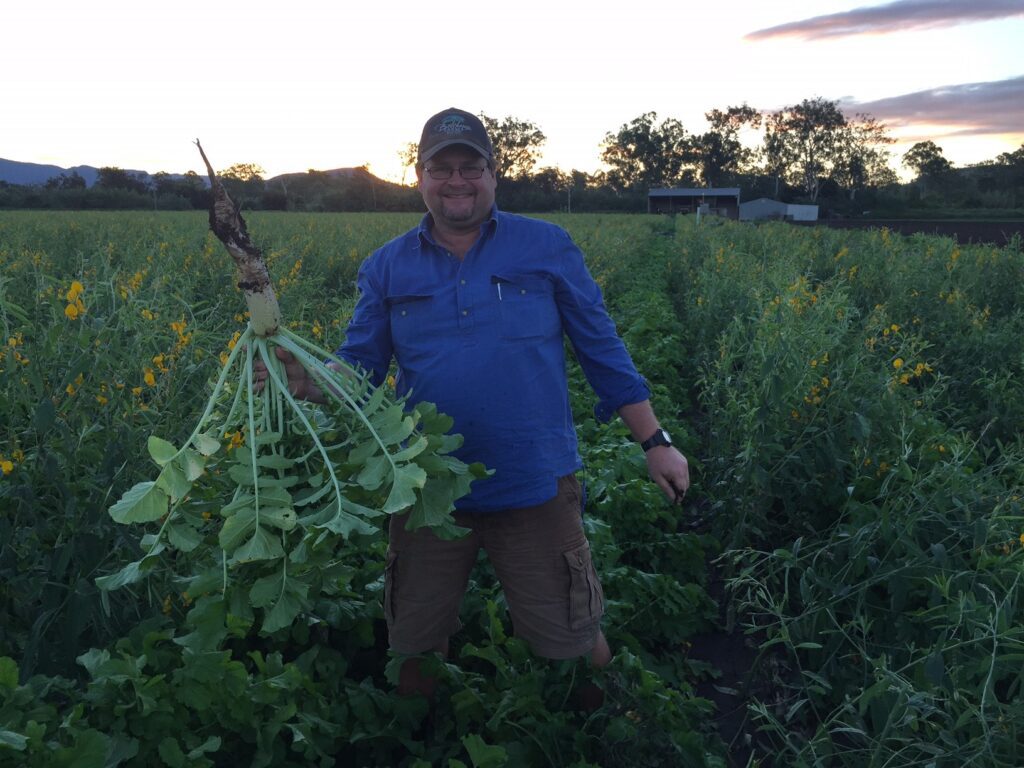Radishes, Forage Rape, Hybrid Barissicas can provide valuable feed options for high animal performance. Different varieties can be used to provide high quality feed, reduce soil compaction, capture nitrogen and provide soil coverage.

Reduce Soil Compaction
Dewatering
Grazing
Tillage Radish is a brassica bred specifically for its large tuber taproot, which is used to reduce soil issues such as compaction. Tillage Radish is also a short term fodder option (10-12 weeks) with first grazing in 5-6 weeks, and 2-3 grazings possible prior to maturity. Tillage Radish produces very palatable feed, appropriate for all cattle and sheep.
Maximum fodder and tuber development occurs when sown in Jan/Feb, although Tillage Radish can also be sown in autumn and spring to provide quick feed options. Strategic grazing can also delay maturity.
When compared to other brassicas, Tillage Radish is a drought hardy, lower risk option due to the energy reserves available in the tuber, and its ability to access subsoil moisture and nutrients.
Rape is the most versatile of the brassica species. It is suited to a wide range of soil types, fertility levels, and environmental conditions. Rape is valued as a finishing crop for sheep, beef and dairy cattle and has flexibility in its sowing times.
Short Type
Quick to Graze
Blue Gorilla is a dark purple green, re-growing forage rape. The stature of Blue Gorilla is slightly shorter than many current varieties but with good standing ability. The dry matter content of Blue Gorilla is higher than average which leads to high total dry matter yields. Furthermore, the high dry matter content means that animals take in more useful food per kilo and are likely to thrive better than on conventional forage rape varieties. Blue Gorilla shows a moderately good resistance to powdery mildew and is quite resistant to clubroot.
Maturity: 10 – 12 weeks
Grazings: 2 – 4
Sowing Rate: 3 – 4 kg/ha
Grazing
Economical
High leaf to stem ratio for excellent utilisation rates. Tolerant of dry conditions once established. Ideal for Summer, Autumn, and Winter Feed
Maturity: 10 – 12 weeks
Grazings: 2 – 4
Sowing Rate: 3 – 4 kg/ha
Tall Type
Winter Feed
Greenland fodder rape was bred in 2006, and has had great success in trials and commercial applications. Greenland is well adapted to sowing opportunities throughout the year, provided adequate moisture is available. Greenland provides abundant, highly palatable fodder from spring and autumn sowings, helping to finish livestock in summer and maintain livestock in winter. The variety also has a short, thick stem which allows excellent recovery and persistence through multiple grazings.
Maturity: 10 – 13 weeks
Grazings: 2 – 4
Sowing Rate: 3 – 4 kg/ha
Leafy Turnips are created by crossing a turnip with an Asiatic leaf vegetable, kale or rape. The resulting plant is quick growing and leafy with minimal bulb development. Hybrid brassicas are able to produce large amounts of high-quality feed in multiple summer-grazings, and are also suitable for autumn sowing. Hybrid brassicas produce feed that is highly palatable and digestible, and have outstanding regrowth potential.
Turnips can be utilised for both their leaf and bulb production. They are classified by the shape of the bulb. Tankard (summer turnip) have only 40% of their bulb below the ground making them more accessible to stock, while globe shaped turnips have about 90% of the bulb growing below ground, hindering stock access. Remaining bulbs should not be left in the paddock and will need to be cultivated after the tops have been grazed.
Leafy Growth
Multiple Grazing
Quick to graze
Quick, short-term, palatable, high quality feed is what you can achieve from this annual hybrid brassica, that is capable of providing high yields from multiple grazings’ when grown on fertile soils and is properly managed.
Maturity: 6 – 8 weeks
Grazings: 2 – 4
Sowing Rate: 4 – 5 kg/ha
Globe Type
Single Grazing
Longer Ripening
A single graze turnip that has been widely adapted, is cost-effective, and suitable for dairy, beef or sheep grazing.
Maturity: 12 – 14 weeks
Grazings: 1
Sowing Rate: 0.5 – 2 kg/ha

Gippsland, Yarra Valley, SW Vic, & Lower SE SA
0409 776 126
rhys.cs@agfseeds.com.au

Northern NSW & Queensland
0499 456 263
will.bazley@agfseeds.com.au

Victorian Mallee & South Australia
0448 863 169
craig.altmann@agfseeds.com.au

South East NSW & North East Victoria
0491 219 291
cooper.lambden@agfseeds.com.au

SW Vic, Central Vic, SE South Australia, Murray NSW & Tasmania
0497 432 157
ivan.pyke@agfseeds.com.au
NOTICE: Although the information and recommendations in this guide are presented in good faith and believed to be correct, AGF Seeds Pty. Ltd. makes no representations or warranties as to the completeness or accuracy of Information. Information is supplied upon the condition that the persons receiving same will make their own determination as to its suitability for their purposes prior to use. In no event will AGF Seeds Pty. Ltd. be responsible for any damages or loss of any nature whatsoever resulting from the use of or reliance upon Information supplied in this guide.